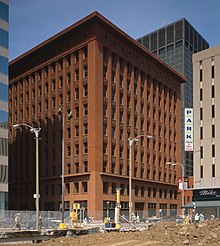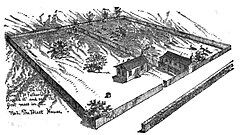Architecture of St. Louis
The architecture of St. Louis exhibits a variety of commercial, residential, and monumental
Skyscrapers
St. Louis was home to a cluster of early skyscrapers during the late 19th century. Two of Louis Sullivan's important early skyscrapers stand among a crop of similar office buildings and department stores built up between 1890 and 1915. His Wainwright Building (1891) features strong base-pediment-shaft massing and an insistently vertical pattern of ornament; his Union Trust Building of 1893 was stripped of its cave-like street-level ironwork in 1924.

Beyond Sullivan's work, other significant downtown skyscrapers of those years were
In
Some notable post-modern commercial skyscrapers were built downtown in the 1970s and 1980s, including the
During the 1990s, St. Louis saw the construction of the largest United States courthouse by area, the Thomas F. Eagleton United States Courthouse (completed in 2000). The Eagleton Courthouse is home to the United States District Court for the Eastern District of Missouri and the United States Court of Appeals for the Eighth Circuit. The most recent high-rise buildings in St. Louis include two residential towers: the Park East Tower in the Central West End and the Roberts Tower located downtown, and One Hundred Above the Park in the Central West End, the tallest building outside of downtown.
Landmarks and monuments

Several examples of religious structures are extant from the pre-Civil War period, and most reflect the common residential styles of the time. Among the earliest is the Basilica of St. Louis, King of France (locally referred to as the Old Cathedral). The Basilica was built between 1831 and 1834 in the Federal style. Other religious buildings from the period include SS. Cyril and Methodius Church (1857) in the Romanesque Revival style and Christ Church Cathedral (completed in 1867, designed in 1859) in the Gothic Revival style.
Only a few civic buildings were constructed during the early 19th century. The original St. Louis courthouse was built in 1826 and featured a Federal-style stone facade with a rounded portico. However, this courthouse was replaced during the renovation and expansion of the building in the 1850s. The
Because much of the city's early commercial and industrial development was centered along the riverfront, many pre-Civil War buildings were demolished during the construction of the

St. Louis saw a vast expansion in the variety and number of religious buildings during the late 19th century and early 20th century. The largest and most ornate of these is the

Early in the 20th century (and during the years before and after the 1904 World's Fair), several churches moved to the Central West End neighborhood, near
By the

Louis Sullivan designed Charlotte Dickson Wainwright's tomb on the north side of Bellefontaine Cemetery, surrounded by a collection of similar tombs for the great old St. Louis families, interesting for their late-Gilded Age artwork.
Shortly after the Civil War, St. Louis rapidly increased its school system and hospital system. One of the earliest structures and the oldest extant hospital building in St. Louis is the St. Louis Insane Asylum (now the Metropolitan St. Louis Psychiatric Center). The asylum is built of brick in the Italianate style, complete with a cast-iron dome and cupola reminiscent of the Old Courthouse.
As St. Louis expanded, the city hall was moved further west of downtown to its present location in 1904 (construction began in 1892). St. Louis City Hall, still in use, was designed by Harvey Ellis in the Renaissance Revival style. City Hall also is reminiscent of the famed Hôtel de Ville, Paris, France.
Other significant civic buildings from the late 19th century and early 20th century include the
Then into the 1940s and 1950s, a certain subgenre of St. Louis modernism emerged, with the locally important
Residential forms
The earliest buildings in St. Louis were constructed in the French Colonial style. Although Spain took possession of the
The second type was a


The third style of early St. Louis homes was a rock house. Only the wealthiest St. Louisans might afford a home built entirely of rock walls with a masonry foundation due to the difficulty of construction. The earliest house in St. Louis, the home of
Rural houses
The earliest American homes in St. Louis were crude, usually of log construction. Outlying homes in the farmlands were minimally ornamented and were usually of one or two-room construction. However, some rural homes were of the
The more developed rural homes in early St. Louis often bear the mark of the
Other rural styles found in early St. Louis included
Other early influences included German architecture, specifically the fachwerk construction method. Fachwerk construction generally has been enclosed in wooden siding, making such homes appear to be traditional frame homes. Because of the relative difficulty of fachwerk construction, few homes were built after 1840 using the technique. Almost all examples of fachwerk construction exist within the Soulard or Carondelet neighborhoods. German immigrants also brought with them a tradition of stone house construction, with several examples remaining in the Carondelet neighborhood.
Urban houses
The majority of urban homes were of the townhouse type (also known as
Some less ornamented urban house designs also originated in the pre-Civil War period. These include a variety of shotgun houses, narrow-front houses with side entry, and flounder houses. St. Louis is home to a large collection of flounder houses, which are narrow homes with side entry but having a sloped roof moving from a side wall to another side wall, often with the gable facing the street. In the working-class neighborhoods of St. Louis where space was at a premium, tenement houses often faced a street while flounder houses faced an alleyway on the same lot.
St. Louis' residential stock expanded dramatically during the late 19th century and early 20th century. Like many other cities, St. Louis has its share of Victorian homes, including a fair number of
Among the significant styles found in the private places are
After World War I, many new homes began to reflect the Colonial Revival style, with traditional brick, dormers, cornices, and strict symmetry. A prime example of St. Louis Colonial Revival is located at 47 Portland Place. Much of St. Louis' working-class housing in the 1920s and 1930s were bungalows, which appear throughout south St. Louis. At the same time, the central corridor extending west from downtown saw an increase in low-rise and high-rise apartment buildings.
Some of the more opulent residential architecture of the 1920s and 1930s was among these apartments and hotels. The
Few civic buildings existed during the French period, during which time government business often was conducted at the home of the governor (usually the home of Pierre Laclede). The first (and only) religious structure was a palisaded church now, built circa 1770, which was replaced in the early 1810s (and replaced again in 1834 by the Basilica of St. Louis, King of France).
After the sale of Louisiana (including St. Louis) to the United States in 1804, more Americans began moving to the village. These Americans built homes of frame construction prior to the mid-1810s, but after this point, began building using brick. Some photographs exist of these early structures and of French residences from the 18th century; however, no examples of colonial-era structures are known to exist in St. Louis.
Urban renewal and preservation
After the 1950s, suburban expansion reduced the commercial and residential density of the city, while in 1957, nearby Clayton, Missouri eliminated its height limitations on buildings. Clayton, which is the county seat of St. Louis County, Missouri, became an alternative to downtown St. Louis for commercial construction in the 1960s and 1970s. Various urban renewal projects cleared several low-income areas of St. Louis for residential housing projects.
The first of these projects was the relatively successful Cochran Gardens, constructed in 1953 and home to white residents until 1956 when the project was integrated. Shortly after the construction of Cochran Gardens, the later-infamous Pruitt–Igoe project replaced the DeSoto-Carr neighborhood with its 33 eleven-story towers. By the mid-to-late 1960s, these projects had become decayed themselves. Although Pruitt–Igoe was designed by Minoru Yamasaki with several innovative living features, the project ultimately was demolished in the 1970s. Although Cochran Gardens' management was turned over to a tenant association in 1976, it later returned to city control in the 1990s and was demolished in 2008 after several years of decay.
In recent years, several organizations have attempted to promote the
Architects of St. Louis
- Harris Armstrong
- George I. Barnett
- Thomas P. Barnett
- William Bernoudy
- Charles B. Clarke
- Eames and Young
- William B. Ittner
- George Kessler, city planner
- Theodore Link
- John Mauran
- HOK
Images
-
Cathedral Basilica of St. Louis
-
the Climatron
-
St. Louis Science Center
-
Bryan Hall in Washington University in St. Louis
-
St. Louis Union Station Grand Hall
-
Gateway Arch from the mall
-
City House inSecond Empire style townhouse
-
Old Grand Avenue Water Tower, 1871
-
Rows of Lafayette Square townhouses surround the city's oldest public park
-
Picture of theMetropolitan Police Department, City of St. LouisPolice Headquarters.
See also
- Caves of St. Louis
- History of St. Louis, Missouri
- List of public art in St. Louis
- National Register of Historic Places listings in St. Louis (city, A-L)
- National Register of Historic Places listings in St. Louis (city, M–Z)
- National Register of Historic Places listings in St. Louis County, Missouri
- Streetcars in St. Louis
















